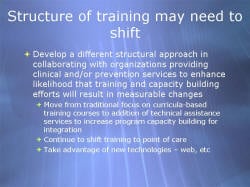Slide Set J: Workforce Development and Training
Download the complete slide set:
While the content is in the public domain and no copyright restriction applies, we do ask that users preserve the slides in their current format and cite CDC as the source.

Slide 1
Workforce Development & Training
PDF Filepdf icon or PPT Fileppt icon

Slide 2
Today’s Discussion
PDF Filepdf icon or PPT Fileppt icon

Slide 3
Workforce Development and Training: Translating Research into Practice & Policy
PDF Filepdf icon or PPT Fileppt icon

Slide 4
An Example of Workforce Development Integration: The National Network of STD/HIV Prevention Training Centers
PDF Filepdf icon or PPT Fileppt icon

Slide 5
NNPTC: 3 Parts
PDF Filepdf icon or PPT Fileppt icon

Slide 6
The NNPTC Mission: The Text
PDF Filepdf icon or PPT Fileppt icon

Slide 7
The NNPTC Mission: The Reality
PDF Filepdf icon or PPT Fileppt icon

Slide 8
NNPTC Integrative Capacity Enhanced by Broad Expertise & Communication
PDF Filepdf icon or PPT Fileppt icon

Slide 9
NNPTC Contributions Are Enhanced by Strategic External Collaborations
PDF Filepdf icon or PPT Fileppt icon

Slide 10
NNPTC Contributions Are Enhanced by HIV-STD Expertise
PDF Filepdf icon or PPT Fileppt icon

Slide 11
Incorporating HIV Prevention into the Medical Care of Persons Living with HIV
PDF Filepdf icon or PPT Fileppt icon

Slide 12
CDC Recommendations
PDF Filepdf icon or PPT Fileppt icon

Slide 13
ASI Curriculum Content
PDF Filepdf icon or PPT Fileppt icon

Slide 14
Ask, Screen, Intervene
PDF Filepdf icon or PPT Fileppt icon

Slide 15
Ask, Screen, Intervene: Collaboration among trainers
PDF Filepdf icon or PPT Fileppt icon

Slide 16
Ask, Screen, Intervene: Collaboration with medical professionals
PDF Filepdf icon or PPT Fileppt icon

Slide 17
ASI: Self-evaluation of Clinician Trainees
PDF Filepdf icon or PPT Fileppt icon

Slide 18
Integration that Worked! ASI bridged:
PDF Filepdf icon or PPT Fileppt icon

Slide 19
Workforce Development and Training: Translating Research into Practice & Policy
PDF Filepdf icon or PPT Fileppt icon

Slide 20
Two Realms of Workforce Development and Training
PDF Filepdf icon or PPT Fileppt icon

Slide 21
Big picture training issues
PDF Filepdf icon or PPT Fileppt icon

Slide 22
Outside input needed to support workforce development
PDF Filepdf icon or PPT Fileppt icon

Slide 23
Current training partners will need to further collaborate
PDF Filepdf icon or PPT Fileppt icon

Slide 24
Training needed on integration itself
PDF Filepdf icon or PPT Fileppt icon

Slide 25
Culture of training may need to shift
PDF Filepdf icon or PPT Fileppt icon

Slide 26
Structure of training may need to shift
PDF Filepdf icon or PPT Fileppt icon
Slide 27
The great aim of education is not knowledge, but action. -Herbert Spencer
PDF Filepdf icon or PPT Fileppt icon



